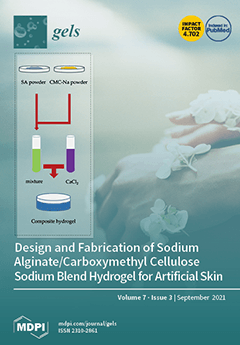Cryogels attained from natural materials offer exceptional properties in applications such as tissue engineering. Moreover, Halloysite Nanotubes (HNT) at 1:0.5 weight ratio were embedded into CS cryogels to render additional biomedical properties. The hemolysis index of CS cryogel and CS:HNT cryogels was calculated
[...] Read more.
Cryogels attained from natural materials offer exceptional properties in applications such as tissue engineering. Moreover, Halloysite Nanotubes (HNT) at 1:0.5 weight ratio were embedded into CS cryogels to render additional biomedical properties. The hemolysis index of CS cryogel and CS:HNT cryogels was calculated as 0.77 ± 0.41 and 0.81 ± 0.24 and defined as non-hemolytic materials. However, the blood coagulation indices of CS cryogel and CS:HNT cryogels were determined as 76 ± 2% and 68 ± 3%, suggesting a mild blood clotting capability. The maximum% swelling capacity of CS cryogel was measured as 3587 ± 186%, 4014 ± 184%, and 3984 ± 113%, at pH 1.0, pH 7.4 and pH 9.0, respectively, which were reduced to 1961 ± 288%, 2816 ± 192, 2405 ± 73%, respectively, for CS:HNT cryogel. It was found that CS cryogels can hydrolytically be degraded 41 ± 1% (by wt) in 16-day incubation, whereas the CS:HNT cryogels degraded by 30 ± 1 wt %. There is no chelation for HNT and 67.5 ± 1% Cu(II) chelation for linear CS was measured. On the other hand, the CS cryogel and CS:HNT cryogel revealed Cu(II) chelating capabilities of 60.1 ± 12.5%, and 43.2 ± 17.5%, respectively, from 0.1 mg/mL Cu(II) ion stock solution. Additionally, at 0.5 mg/mL CS, CS:HNT, and HNT, the Fe(II) chelation capacity of 99.7 ± 0.6, 86.2 ± 4.7% and only 11.9 ± 4.5% were measured, respectively, while no Fe(II) was chelated by linear CS chelated Fe(II). As the adjustable and controllable swelling properties of cryogels are important parameters in biomedical applications, the swelling properties of CS cryogels, at different solution pHs, e.g., at the solution pHs of 1.0, 7.4 and 9.0, were measured as 3587 ± 186%, 4014 ± 184%, and 3984 ± 113%, respectively, and the maximum selling% values of CS:HNT cryogels were determined as 1961 ± 288%, 2816 ± 192, 2405 ± 73%, respectively, at the same conditions. Alpha glucosidase enzyme interactions were investigated and found that CS-based cryogels can stimulate this enzyme at any CS formulation.
Full article






